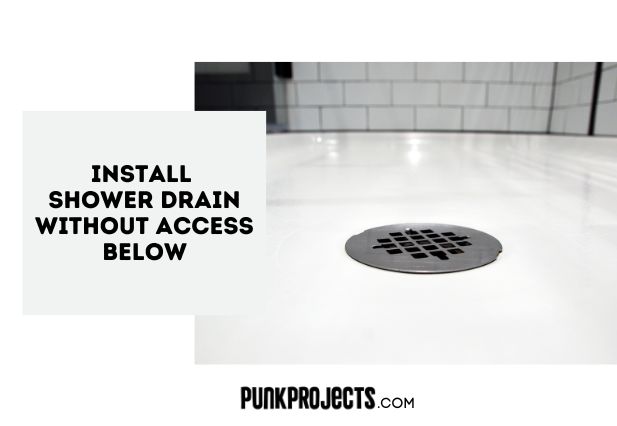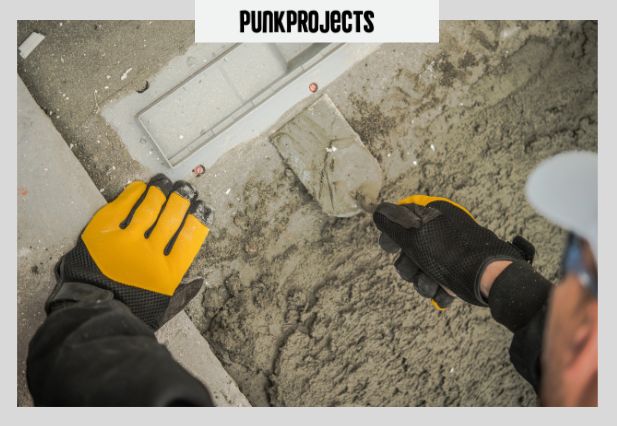Replace Shower Drain Without Access Below

The dreaded slow drain. For homeowners, it’s more than just an inconvenience; it signals a looming battle with plumbing, often leading to costly repairs and disruptive renovations. The shower drain, in particular, presents a unique challenge: replacement typically necessitates access from below, a luxury many lack.
But despair not, besieged homeowner! There are methods, albeit potentially more intricate, that allow for shower drain replacement without the need to tear open ceilings or crawl spaces. This article delves into the techniques, tools, and considerations involved in tackling this common plumbing problem from above, empowering you with the knowledge to assess the situation and potentially even undertake the repair yourself. However, be warned, plumbing complexities can quickly escalate, and when in doubt, consult a qualified professional.
Understanding the Challenge
Replacing a shower drain without access from below is akin to performing surgery through a keyhole. Traditional methods involve loosening the drain assembly from underneath the shower pan or floor, which is impossible if you only have access to the shower itself.
The primary hurdle is disconnecting the old drain and securely attaching the new one, ensuring a watertight seal to prevent leaks that could cause significant water damage. Several factors complicate this process: the age and type of drain, the material of the shower pan, and the available space to maneuver tools.
Identifying Your Drain Type
Shower drains come in various configurations, each requiring a slightly different approach. Common types include compression drains, threaded drains, and solvent-welded (glued) drains. Compression drains use rubber gaskets and tightening nuts to create a seal.
Threaded drains, as the name suggests, screw into a receiving fitting. Solvent-welded drains are permanently bonded with PVC or ABS cement and present the greatest challenge for removal.
Knowing which type you have is crucial for selecting the appropriate removal and replacement method. Visual inspection is the first step, but sometimes the drain type is obscured by grime or rust.
Methods for Top-Side Drain Replacement
Several techniques exist for replacing a shower drain without access from below. These methods generally involve cutting, twisting, or leveraging the old drain out and then installing a new drain assembly from above.
One popular approach utilizes an internal pipe wrench or a specialized drain removal tool. These tools grip the inside of the drain body, allowing you to unscrew or break it free from the existing plumbing.
Another method involves carefully cutting the drain pipe with a reciprocating saw or a rotary tool equipped with a cutting wheel. The goal is to sever the drain pipe without damaging the shower pan or the surrounding plumbing. This requires extreme caution and precision.
The "Cut and Glue" Method
This approach, often used for solvent-welded drains, involves carefully cutting the drain pipe as close as possible to the shower pan. A new drain assembly with a rubber gasket is then installed from above, creating a watertight seal. The connection between the new drain and the existing pipe is typically made using a flexible coupling or a transition fitting and PVC or ABS cement.
This method requires careful measurement and precise cuts to ensure a proper fit. The success of this method hinges on the quality of the seal created by the rubber gasket and the secure connection between the new drain and the existing plumbing.
Using a Drain Removal Tool
Specialized drain removal tools, such as internal pipe wrenches or drain keys, are designed to grip the inside of the drain and allow you to unscrew it from above. These tools often come with multiple attachments to accommodate different drain sizes and configurations.
The advantage of this method is that it avoids the need for cutting, reducing the risk of damage to the shower pan. However, this approach may not be effective if the drain is heavily corroded or seized in place.
Essential Tools and Materials
Regardless of the method chosen, certain tools and materials are essential for shower drain replacement: a new drain assembly (matching the existing type if possible), a pipe wrench or drain removal tool, a reciprocating saw or rotary tool (if cutting is required), PVC or ABS cement (if solvent welding is involved), a flexible coupling or transition fitting (if needed), plumber's putty or silicone caulk, a putty knife, rags, and safety glasses.
Consider investing in high-quality tools to ensure a clean and efficient repair. Safety should always be a top priority; wear safety glasses and gloves to protect yourself from debris and chemicals.
Potential Pitfalls and Considerations
Replacing a shower drain without access from below carries inherent risks. The shower pan can be easily damaged during the removal process, leading to costly repairs or even the need to replace the entire shower.
Improperly installed drains can leak, causing water damage to the subfloor, walls, and ceilings below. Existing plumbing may be brittle or corroded, increasing the risk of breakage during the repair.
Before attempting any drain replacement, thoroughly assess the condition of the shower pan and the surrounding plumbing. If you encounter any signs of significant damage or corrosion, consult a qualified plumber.
When to Call a Professional
While replacing a shower drain from above is feasible for some homeowners, there are situations where professional help is strongly recommended. If you are uncomfortable working with plumbing or lack the necessary tools and experience, it is best to err on the side of caution.
If the existing drain is severely corroded or seized in place, attempting to remove it yourself could cause further damage. If you suspect that the shower pan is damaged or that the surrounding plumbing is compromised, consult a plumber before proceeding.
According to the Environmental Protection Agency (EPA), improper plumbing repairs can lead to water damage and mold growth, which can pose health risks. A qualified plumber has the knowledge and experience to ensure that the repair is done safely and correctly.
Looking Ahead: Preventative Measures
Preventing future drain clogs is key to prolonging the life of your shower drain. Regularly cleaning the drain strainer or using a drain screen can prevent hair, soap scum, and other debris from entering the drainpipe. Avoid pouring harsh chemicals down the drain, as these can corrode the pipes and damage the drain assembly.
Periodic inspection of the drain and surrounding area can help identify potential problems early on, allowing for timely repairs and preventing costly damage. Consider using enzyme-based drain cleaners to break down organic matter without harming the plumbing.
Replacing a shower drain without access from below is a challenging but achievable task. By understanding the different methods, tools, and potential pitfalls, homeowners can make informed decisions about tackling this common plumbing problem. However, when in doubt, remember that a qualified plumber is always the best resource for ensuring a safe and effective repair.
![Replace Shower Drain Without Access Below Install Shower Drain Without Access below [Step-by-Step Guide]](https://homeunderstandable.com/wp-content/uploads/2023/08/Install-Shower-Drain-Without-Access-below-1.jpg)



![Replace Shower Drain Without Access Below Install Shower Drain Without Access below [Step-by-Step Guide]](https://homeunderstandable.com/wp-content/uploads/2023/08/Can-You-Install-A-Shower-Drain-From-The-Top-768x461.jpg)

![Replace Shower Drain Without Access Below Install Shower Drain Without Access below [Step-by-Step Guide]](https://homeunderstandable.com/wp-content/uploads/2023/08/Loud-Shower-Drain.jpg)

![Replace Shower Drain Without Access Below Install Shower Drain Without Access below [Step-by-Step Guide]](https://homeunderstandable.com/wp-content/uploads/2023/08/How-to-Remove-Square-Shower-Drain-Cover--768x461.jpg)
![Replace Shower Drain Without Access Below Install Shower Drain Without Access below [Step-by-Step Guide]](https://homeunderstandable.com/wp-content/uploads/2023/08/How-to-Install-a-Shower-Drain-Trap-768x461.jpg)

![Replace Shower Drain Without Access Below Install Shower Drain Without Access below [Step-by-Step Guide]](https://homeunderstandable.com/wp-content/uploads/2023/08/Relocate-Shower-Drain-in-Concrete-Slab-768x461.jpg)
![Replace Shower Drain Without Access Below Install Shower Drain Without Access below [Step-by-Step Guide]](https://homeunderstandable.com/wp-content/uploads/2023/08/Inch-And-a-Half-Shower-Drain-768x461.jpg)
![Replace Shower Drain Without Access Below Install Shower Drain Without Access below [Step-by-Step Guide]](https://homeunderstandable.com/wp-content/uploads/2023/08/Casper-Shower-Drain-Removal-1536x1152.jpg)
![Replace Shower Drain Without Access Below Install Shower Drain Without Access below [Step-by-Step Guide]](https://homeunderstandable.com/wp-content/uploads/2023/08/Can-a-Shower-Drain-Be-1-12-1024x597.jpg)
![Replace Shower Drain Without Access Below Install Shower Drain Without Access below [Step-by-Step Guide]](https://homeunderstandable.com/wp-content/uploads/2023/08/Glue-in-Shower-Drain.jpg)
![Replace Shower Drain Without Access Below Install Shower Drain Without Access below [Step-by-Step Guide]](https://homeunderstandable.com/wp-content/uploads/2023/08/Should-Shower-Drain-Be-Flush-With-Tile-768x461.jpg)
